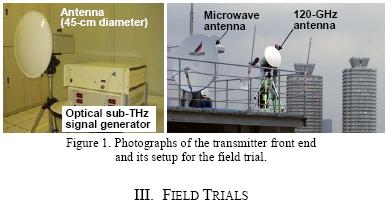Tadao Nagatsuma
NTT Microsystem Integration Laboratories, NTT Corporation
3-1 Morinosato Wakamiya, Atsugi, Kanagawa 243-0198, Japan
ngtm@aecl.ntt.co.jp
Abstract―This paper describes a 10-Gbit/s wireless link system that uses a 120-GHz-band sub-terahertz (sub-THz) electromagnetic waves. Both photonically-assisted and purely electronic approaches have been examined. On-going field trials with TV Broadcast Industry are also demonstrated.
I. INTRODUCTION
Demand is increasing for higher data rate in wireless communications in order to keep up with the remarkable speed-up of fiber-optic networks such as Ethernet LANs. 10-Gbit/s data rate is now required for the transmission of 10-Gigabit Ethernet (10GbE) signals or multiplex transmission of high-definition television (HDTV) signals, with wireless, in particular, for “last one-mile” connections.
One of the most direct and easiest ways to achieve a higher data rate of 10 Gbit/s is to increase carrier frequencies to sub-THz regions of over100 GHz [1-4]. This paper presents our recent challenges for 10-Gbit/s wireless link using a 120-GHz-band sub-THz waves.
II. TECHNOLOGIES
A. Photonic Approaches
In our initial system demonstration, we have employed photonic technologies in the sub-THz transmitter [2, 3]. An optical sub-THz source generates optical subcarrier signals whose intensity is modulated at a frequency of 125 GHz. An optical intensity (ASK) modulator modulates the optical subcarrier signal using digital data signals. The modulated subcarrier signal is amplified by an optical amplifier and input into the photonic sub-THz emitter. In the emitter, a photodiode (PD) converts the optical signals into sub-THz signals, which are amplified and radiated toward the receiver via an antenna. The received sub-THz signals are amplified and demodulated by a simple envelope detection scheme.
We have developed a low-phase-noise tunable optical sub-THz signal source based on optical heterodyning [5]. Optical signals are converted to sub-THz signals using a unitraveling carrier photodiode (UTC-PD). The maximum output power from the UTC-PD now exceeds 10 dBm at a frequency of over 100 GHz [6]. The sub-THz receiver is composed of all-electronic devices using InP-HEMT with a unity current gain frequency ft of 170 GHz and a maximum oscillation frequency fmax of 350 GHz [7].
B. All Electronic Approaches
An MMIC chipset for all-electronic transmitters and receivers has recently been tested successfully. In the onwafer testing, the maximum bit rate obtained with a bit error rate (BER) = 10 -12 is 11 Gbit/s [7].

Figure 1 is a photograph of the photonics-based transmitter setup for a long distance (>1 km) link using a high-gain Cassegrain antenna [8]. The 120-GHz-band wireless link system was licensed by the Japanese Ministry of Internal Affairs and Communications (MIC) as the first experimental radio station using >100-GHz radio waves (output power: 0dBm) in July 2004, and its upgraded version (output power:10 dBm) was licensed in August 2005. This wireless link can support both of 10 GbE (10.3 Gbit/s) and OC-192 (9.95Gbit/s) with a BER of 10-12. We have also succeeded in the wireless transmission of 6-channel uncompressed HDTV signals using the link.
REFERENCES
[1] C. M. Mann, Terahertz Sources and Systems, NATO Science Series, II. Mathematics, Physics and Chemistry-27, Kluwer Academic Publishers, pp. 261-267, 2001.
[2] A. Hirata et al., IEEE J. of Lightwave Technol., 21, pp. 2145-2153, 2003.
[3] A. Hirata et al., IEEE Trans. Microwave Theory Tech., 52, pp.1843-1850, 2004.
[4] R. Piesiewicz et al., Proc. ICECom 2005, pp. 153-157, 2005.
[5] A. Hirata et al., IEICE Trans. Electron., E88-C, pp. 1458-1464, 2005.
[6] H. Ito et al., IEICE Electronics Express, 2, pp.446-450, 2005.
[7] T. Kosugi et al., Tech. Dig. Compound Semiconductor IC Symposium, H. 6L, 2004.
[8] A. Hirata et al., IEEE Trans. Microwave Theory Tech., 54, pp.1937-1944, 2006.

